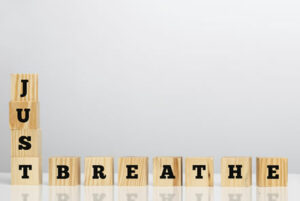As you probably know, it is always important to manage stress. Many preventable diseases can be linked back to an elevated and prolonged stress response in the body. During a health crisis, however, it is of utmost importance for us to maintain calm and access the healing energy of the parasympathetic nervous system.
My Experience with Meditation
I have dabbled with meditation for several years. To improve my meditation habits, I’ve participated in one-on-one and group classes, 21-day challenges, in-person groups, whole day workshops, and online app usage. Additionally, I have read and listened to numerous books, watched online talks, and discussed the topic with various people. With all this knowledge and experience, you’d think I’d have meditation figured out by now! Unfortunately, I don’t–far from it.

I struggle to meditate daily. Actually, my record was 390 consecutive days. After I returned home from the cancer hospital in early November 2018, I committed to meditating every day. And I did, until I left for my crazy trip to New Zealand last December. Although I was consistent, many of the meditations were not of high quality. I realize that is why they call it a “practice,” something you are working to get better at. As with anything that is good for you, it can be overdone. Because I was trying so hard to dedicate to it, meditation became an obligation. Thus, I began to resent it, which eroded the positive benefits.
In my on-again, off-again relationship with meditation, I’m always striving for balance so that I can determine what nourishes me without feeling like a burden. In order to change it up a little, I’ve been experimenting with different practices, like those I describe below. Since meditation is a personal experience, I am finding that it takes time to find the right combination. My advice is to be patient with your practice and let it grow and unfold in its own way, on its own schedule.
Nicely, I have experienced many benefits of quieting my mind through meditation: being able to enjoy the present moment, taking time to savor experiences, having greater focus and concentration, finding pleasure and appreciation in the small things, and feeling connected with myself and others. If these sound like things you’d like to enjoy, take a few minutes each day to find your inner calm.
Meditation Basics
Think of meditation as training for your brain. For example, to make my body stronger, I do intervals on the bike. Similarly, to make my brain stronger, I meditate. As I mentioned in my blog, 5 Lessons from the Mindfulness-Based Stress Reduction (MBSR) course, meditation is a formal mindfulness practice.
When you think of meditation, you probably visualize a picture similar to that at the top of this blog: sitting with an upright spine with the thumb and index finger gently touching. Although not accepted by some, I believe that lying down, where the spine is also straight, is also a good position for meditation. Oftentimes, I recline in static back while meditating. This position has the additional bonus of relaxing the back and hip muscles while balancing the pelvis. Because of this added bonus, I suggest the same reclining position to my clients. However, don’t do it if you are likely to fall asleep! Personally, I have not ever fallen asleep while meditating in static back. On the contrary, I have had my most profound meditation experiences in this position.
Eyes open or closed? In the last meditation group I attended, we meditated with our eyes open. In the past, I have always meditated with my eyes closed, so I found keeping my eyes open to be quite a strain. Others in the group liked the practice, though, as it kept them grounded in the room. Additionally, some suggest that if we want to experience the calm of meditation in our daily lives, beyond our formal practice, we need to learn to reach that state with our eyes open as they are during our waking hours. It’s your choice.

Practice 1: Breath
The foundation of meditation is the breath. Most practices start with breathing awareness. In all practices, the Parasympathetic Nervous System is activated on the exhale.
There are several strategies:
- Focus on the movement of your body with each breath, wherever you feel it most. This may be in your torso, at your nostrils or elsewhere. Keep your attention on this area as you breathe deeply in and out.
- Count to slow down and to regulate your inhale and exhale. For this practice, breathing is done in and out the nose. A popular approach is to breathe in fours:
- Inhale for 4 seconds
- Hold for 4 seconds
- Exhale for 4 seconds
- Hold for 4 seconds
If four doesn’t feel right for you, change the number to what suits your breathing pattern.
- You can also modify your breathing rhythm to emphasize the exhale, making it up to twice as long as the inhale.
- Inhale for 3 seconds
- Pause
- Exhale for 6 seconds
- Pause
Practice 2: Repetition
Each repetition practice can be done silently or said aloud.
Mantra
You can use any word or phrase as a mantra to repeat, such as om, world peace, love, vibrant health, etc.
Mantras can be repeated with the inhale and exhale:
Inhale: Calm
Exhale: Fear
Generally, you inhale what you want to bring in, and exhale what you want to release.

Mala
A mala is a string of beads that can be used to count your mantras. This gives you a tactile sensation and provides a task for your hands, which can help keep you focused. I use a mala that slips over my wrist. You can also purchase longer malas that are worn as necklaces.
Multiple Phrases
- Loving Kindness (Metta)
This is generally done in stages, including saying the phrases to yourself, another person and the larger community. Although this is the formal practice, I encourage you to start wherever feels right for you. For example, some people feel more comfortable saying these phrases to someone else before themselves. Start each mantra with “May (I, you, all) . . .” and then finish the phrase with these endings, in order:
- . . . be happy
- . . . be well
- . . . be peaceful
- . . . feel loved
- . . . live with ease
- Hoʻoponopono
This is used by Hawaiian healers and was taught to me by a good friend and fellow wellness professional, Patricia Wald-Hopkins @ Mariposa Body.
I’m Sorry
Please Forgive Me
Thank You
I Love You
If any of these practices intrigue you, I suggest you research them further since I have only given a brief introduction to spark some ideas. You can find samples of all these types of meditations on the app InsightTimer. There are many other apps out there that may also have similar meditations. I personally use InsightTimer, which is why I mention it specifically.
Practice 3: Body Sensations
Body Scan
This is one of the first meditations taught in the MBSR course. In this meditation you take a slow trip around your body while noticing the sensations in each area. Dr. Kristin Neff, a leading researcher in self-compassion, has several free guided meditations on her website, including compassionate body scan, loving-kindness, affectionate breathing, and more.
Sound
We are constantly surrounded by sounds, many of which we don’t even notice, such as the hum of the computer, heater, or refrigerator. In this meditation, focus on all that you can hear, and pay close attention to sounds that are near and far.

Vision
Pick an object to focus on for this meditation, such as a candle, flower, or picture. Keep a soft gaze on the item while breathing deeply.
Tips for Your Meditation
Although it looks like you’re not doing anything when you’re meditating, you are working your brain in a new way. As you try to meditate, your focus will drift and thoughts will come in. This is normal. Our brain likes to think. Noticing that you are thinking means that you are aware and present.
When a thought comes in, just acknowledge it and return to your practice. This will happen over and over. Since this is bound to happen, try not to become emotional about these lapses in focus. Just keep bringing your attention back again and again. One image that I have found helpful is lilies floating down a stream. When a thought comes in, put it on a lily and let it float downstream out of your awareness.
Even in these difficult and uncertain times, there are opportunities. Instead of worrying about excessive hand washing or hoarding supplies, invest in yourself and your health. Adopt a new habit that will make you stronger and improve your resilience today and for the long term.



